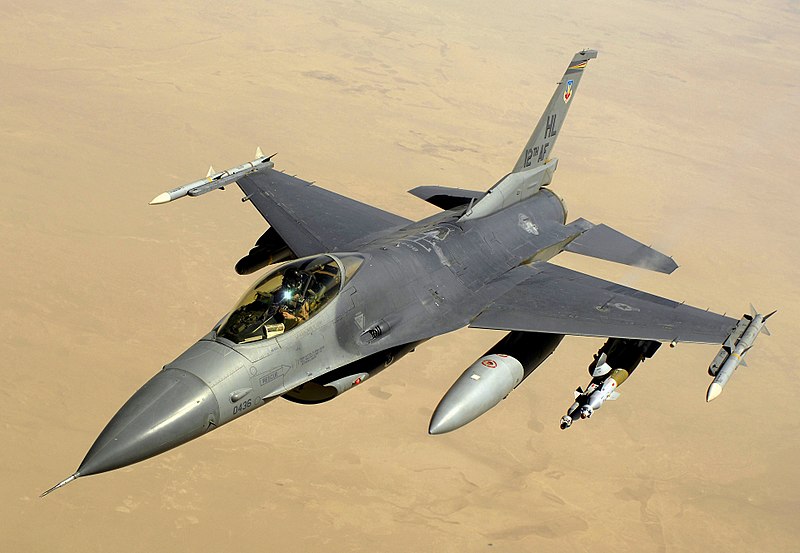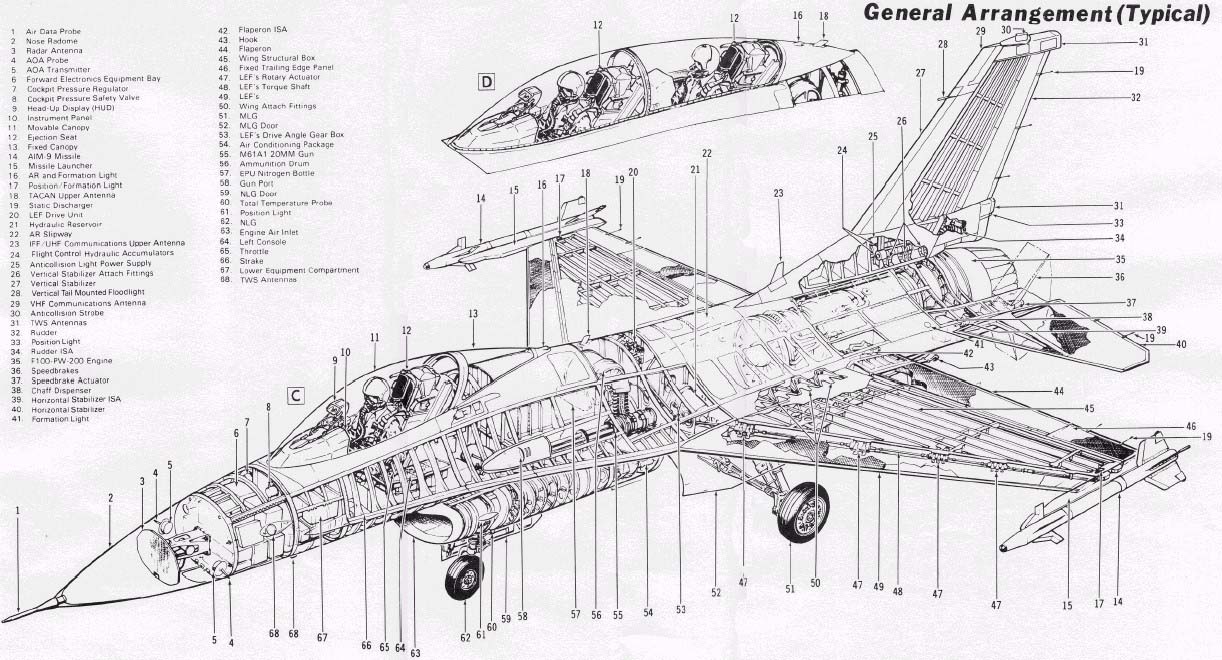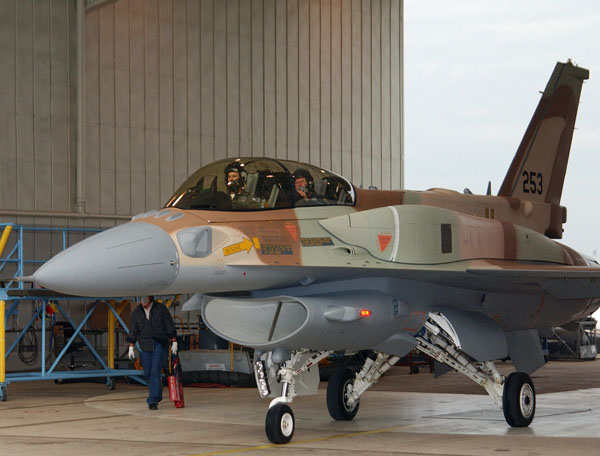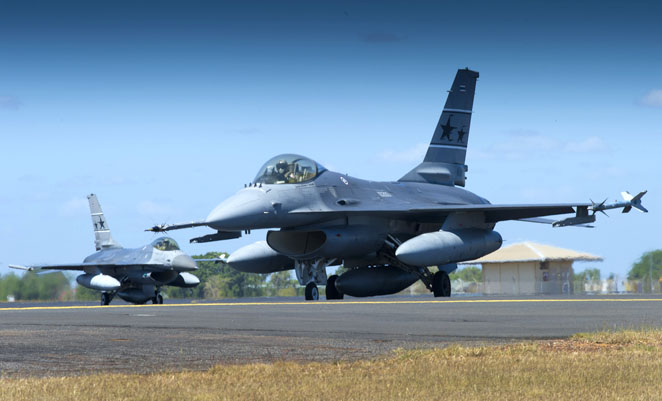رد: ضمن صفقة تشمل 20 طائرة.. أربع طائرات إف 16 تغادر الولايات المتحدة فى طريقها إلى مصر
تم الدمج للاستفادة من المشاركات المفيدة ,,
تم الدمج للاستفادة من المشاركات المفيدة ,,
Follow along with the video below to see how to install our site as a web app on your home screen.
ملاحظة: This feature may not be available in some browsers.
ارجو توضيح بسيط من الأستاذ مرشال
حضرتك حسب كلامك ان f-16 المصريه لا تمتلك اجهزة iff ويتم طلائها باللون البرتقالي للتميز بينها وبين الاسرائيليه
طيب الم يخطر ببال القاده المصريين ان اسرائيل يمكن ان تطلي طائراتها وقت الهجوم بنفس اللون حتي يعتقد انها طائرات مصريه ولا يهاجمها الدفاع الجوي ولا الطيران المصري ؟!!! اعتقد ان القاده ليسوا بهذه السذاجه لترك مصير طائراتنا بيد ( بتاع دوكو اسرائيلي)... :shiny01[1]:
AN/APX-113 IFF
(United States)
Notes: This IFF interrogator/transponder replaced the AN/APX-101 on later-production (Block 25 and later) examples of the F-16 Falcon. It has also now been retrofitted to USAF F-15C Eagles, and to the entire Dutch and Turkish F-16 Falcon fleets regardless of age. Taiwan has also retrofitted it to the it’s IDF Ching Kuo fleet, as has Japan to it’s Mitsubishi F-2 fleet. The visible component is a small black fuselage antenna.
USERS: United States, Israel, Japan, Netherlands, Oman, Taiwan, Turkey, United Arab Emirates
Several countries are gearing up to award multibillion-dollar contracts to upgrade their national combat identification systems and make them compatible with NATO standards.
Egypt, Greece, Sweden and Saudi Arabia are among those nations expected to acquire combat ID electronics, which are installed on weapon systems to help prevent fratricide.
The United Kingdom already has invested hundreds of millions of dollars in this technology. Two years ago, it started a Successor Identification Friend or Foe program, or SIFF.
IFF systems, installed in weapons and surveillance systems, interrogate potential targets. The friendly platforms have transponders that, upon being interrogated, identify those platforms.
Companies such as Raytheon, Northrop Grumman, BAE Systems and Thales are competing for a piece of the pie in upcoming IFF programs. Industry sources said that the U.K. IFF program offered proof of the complexity and considerable costs associated with these technologies.
Egypt issued a request for proposals and companies had until the first of September to submit their plans, Raytheon’s Bob Askin told National Defense. The competitors in this program—expected to be worth at least 500 million Euros—are Raytheon, BAE Systems and Northrop Grumman. Northrop officials declined to confirm the company’s participation, citing competitive concerns.
الصراع بين رايثيون و bae ونورثروب جرومان التي اعتذرت
The Egyptian government has been under pressure to get the IFF program under way. During Operation Desert Storm, in 1991, Egypt could not fly its F-16 and Mirage fighter jets in the U.S.-led coalition, because the aircraft did not have NATO interoperable combat ID systems.
مدير رايثيون يقول أن مصر تحت ضغط للدخول في برنامج iff يعني النظام الأساسي ولو قلنا بأنه قال مصر تريد aiff فسأفترض انها ترقية لمنظومات موجوده لكن الحديث عن بداية البرنامج ككل
“They did not fly a minute—300 airplanes sitting on the ground totally useless, because, if they ever flew, we would shoot them out of the sky,” said Askin.
سنضربهم في السماء ... يعني ببساطه لا يوجد iff
According to Pat McMahon, BAE Systems’ vice president and general manager for IFF and display systems, the company’s combined interrogator transponder (CIT) is the preferred technology for the airborne interrogator in the Egyptian program.
مدير bae يروج لسلعته
The KIV-6 Cryptographic Computer is a component of the CIT Identification Friend or Foe (IFF), Mark (MK) XII AN/APX-111(V) and AN/APX-113 IFF, which is currently installed on the F/A-18, F-16 fighters and SH-60 helicopters.
Under the U.S. rules of engagement, positive identification of an airborne target is required before employing air-to-air weapons beyond visual range. The CIT/IFF with the KIV-6 computer, claim BAE officials, can identify an aircraft as friend or foe and helps engage the enemy with air-to-air missiles beyond the pilot’s visual range.
In the United States, BAE has been involved in the Defense Department’s implementation of the joint US/NATO Mark XII A Electronic Identification Program, said McMahon. BAE also received contracts for IFF upgrade programs in Turkey, Denmark, Norway and South Korea, said McMahon.
The funding for the Greek IFF program remains uncertain. The competing companies are aware of Greece’s requirements, “but their procurement plan is still very immature,” said Askin. The value of this program will probably be similar to that of Egypt’s, he said. “The expectation is that they will start to put some hard requirements and requests for proposal out within the next year.”
The IFF program for Greece should be similar to that of the United Kingdom, said industry officials. The Greek military services are seeking a combat ID system that would make them interoperable with other NATO forces.
“They have got a whole bunch of capabilities for their own national defense, which is important, but they don’t have the ability yet to use any of that weaponry with NATO, to fight in an environment with NATO,” said Askin.
The Swedes, meanwhile, have a functional IFF system, said Askin, but the frequency band that it resides in has been taken over by the cellular telephone systems.
An IFF upgrade program in Sweden is expected for 2004 or 2005, said Askin. Prime contenders for this effort are the Swedish firms Ericcson and Saab. “Because it is considered a national security program, it has to be primed by in-country guys,” said Askin.
The United States and other NATO countries have been using the system called Mark XII for a number of years, but the United Kingdom had never implemented an IFF system that was compatible with that standard, according to Askin. “Finally, they spit the bullet and developed the program for successor IFF.”
The U.K. Ministry of Defence selected Raytheon as the prime contractor two years ago for the program, whose value now has exceeded 200 million pounds. Raytheon is responsible of upgrading 1,000 individual platforms for air, land and sea across 40 different types, according to the U.K. Ministry of Defence.
Raytheon also was one of the contractors selected for the IFF system for the Eurofighter Typhoon.
Askin said the 200 million pounds so far spent on the SIFF program are just the beginning. According to the MOD, the program needs to be completed by 2009. Askin said the whole SIFF program could be installed in the next seven years.
Key weapon platforms will be upgraded first, so that they can be used in NATO exercises or conflicts. So far, the company completed design reviews and is getting ready to produce hardware and begin installations, according to Askin. The program’s subcontractors are platform manufacturers such as BAE Systems, Marshal Aerospace and GKN Westland Helicopters Ltd.
“We are going to get their support for purposes of integration and we need to get their help in order to time the right installation schedules,” Askin explained.
Because of its large scope, the program appears to pose considerable challenges in the management of platform integration and logistics, said Askin. “So much has to get done all at once, rather than a platform program by platform program. This is a total turnkey program.”
Askin cautioned that a new IFF system is basically useless until the entire upgrade is complete throughout the force and all the platforms are equipped with the advanced electronics. Nevertheless, he said, once a few dozen airplanes get the ID system installed, they potentially could be ready to fly in coalition operations.
“The whole purpose is obviously to insure that all the U.K. platforms can interoperate with NATO,” he said.
He noted that the technology available today is capable of accomplishing this goal, even though the electronics involved are quite sophisticated. “If we are all on a team, we all have to see each other, but it takes a long time until the whole technology is integrated,” he said.
“I don’t mean to put down the technological need, because obviously you need high-tech stuff to be able to integrate it in high performance aircraft, for example, but it’s so much more than that for the program to be successful,” he added. “After all is said and done, how can you rest assured that the execution of your program plan resulted in a totally interoperable system and every air defense site can see every air plane and every air plane can see every ship and so on.”
All the individual platforms are designed and configured differently, so they would need different types of installations, he said.
There are several steps involved in an IFF upgrade. “The crypto-computers have to be keyed and the keys have to be managed and somebody has to understand the entire systems requirement, and has to be able to execute it. So, it is not just the technology that can do this job.”
The core of the ID system is the crypto-computer, which is inserted in a transponder. When aircraft are in flight, the air defense system—which has the same crypto as that airplane—can interrogate those airplanes and communicate. “A key is something that says the crypto-algorithm is supposed to look like this today, this tomorrow and this the next day,” Askin explained. “If you fly by me today, you and I can communicate, and because we have the same key when you fly by me tomorrow and we still communicate.”
The changes made to the key are classified, Askin continued. The enemy will be trying to listen, but the key changes make jamming and intrusion “almost impossible,” he said.
Even with the best cryptology in the world, however, if the keys are not changed constantly, somebody will manage to break the codes eventually. If enemy forces get the crypto, they can make themselves look like a friend.
“But if you shorten the amount of time they see that crypto and then the crypto changes, you don’t give them time to get in,” he said. “It is like the secret crypto weapon of the IFF.”
The encryption considerations are important for NATO aspirants and non-NATO members, which may end up fighting in coalitions with alliance members.
“This will be a NATO standard system, and it will go to other countries,” Askin noted. “It will go to other NATO allies, but the core part about this is the [crypto] key.” NATO manages the keys, so if it provides an IFF capability to a non-NATO country and wants them to fly with NATO in the conflict, “we distribute the keys, everybody keys up exactly the same way, so we all now look like friends,” said Askin.
“If in the next conflict that world is changed, and if the non-NATO country is no longer a friend, we just don’t give the key to them. They just don’t get the keys anymore.” The combat ID system would then be rendered useless.
According to Askin, Raytheon is already working with the sophomore NATO members—the Czech Republic, Poland and Hungary. The company is also working with Slovakia, he said. “We are actively helping them upgrade their ID systems, but none of them has a total upgrade program to do everything on one budget line,” he said.
PROPOSED FOREIGN MILITARY SALE TO EGYPT ANNOUNCED
The government of Egypt has requested a possible sale of 311 AN/APX-113 Mark XII Airborne Identification Friend or Foe Selective Identification Feature Systems, testing, aircraft integration, spares and repair parts, support equipment, personnel and maintenance training, publications and technical documentation, U.S. government and contractor technical and logistics personnel services, and other related elements of logistics support. The estimated cost is $300 million.
This proposed sale will contribute to the foreign policy and national security of the United States by helping to improve the security of a friendly country which has been and continues to be an important force for political stability and economic progress in Middle East.
Egypt will use this system to upgrade their identification capability and improve the overall air defense system within their country. The IFF system will be integrated into air, sea, and ground defense systems to provide identification of friendly aircraft within the Egyptian airspace. The system will increase interoperability with U.S. forces. Egypt will have no difficulty absorbing this system into their armed forces.
The proposed sale of this equipment and support will not affect the basic military balance in the region.
The principal contractors will be BAE Systems, Advanced System of Greenlawn, N.Y. and Lockheed Martin Tactical Aircraft of Fort Worth, Texas. There are no offset agreements proposed in connection with this potential sale.
Implementation of this proposed sale will not require the assignment of any additional U.S. government or contractor representatives to Egypt.
There will be no adverse impact on U.S. defense readiness as a result of this proposed sale.

Advanced IFF\The AN/APX-113(v) Advanced Identification Friend or Foe system (A-IFF), manufactured by GEC-Marconi Hazeltine (formerly Hazeltine Corporation), is a development of the APX-111 in service on USAF F-16A Air Defense Fighters and Kuwaiti F-18s.
It consists of a Beam Forming Network and a combined Interrogator/Transponder unit and operates via four (rather striking) Forward Fuselage Antennas mounted on the upper forward fuselage in front of the canopy. These "bird slicers" are probably the most noticeable exterior changes for the F-16A/B after completion of the Mid-Life Update. AIFF provides Mk. XV or Mk. XII interrogation and response. Benefits include interrogator/transponder capability (previously transponder only), the support of BVR weapons (e.g. AIM-120) delivery in excess of radar limits, increased range of 100 nm, relative position of friendlies, and reduced chance of fratricide (friendly fire).
The AN/APX-113 was also selected for Greek F-16C/Ds and the Japanese FSX.
[Note: GEC-Marconi acquired Hazeltine Corporation in May 1996.]
Egypt has requested a possible sale of 311 AN/APX-113

طبعا الصوره حديثه العهد ، اف-16 بلوك 40 مصريه لا تحتوي علي اجهزه تعريف العدو من الصديق IFF وهي عباره عن اربع نتوات تكون امام زجاج الطائره كماهي واضحه في البلوك 52 اسفله.

اف-16 بلوك 52 المصريه الجديده مزوده بأجهزه تعريف العدو من الصديق IFF


انظمه iff فى البلوك 40 \42 غير البلوك 50\52 .....

صوره للاف 16 بلوك 40 امريكيه فى ق العراق سنه 2008 ولا توجد عليها انظمه التعرف التى توجد على البلوك 50\52....النظتمين يختلفان فى الشكل ......
شكرا استاذ مرشال علي الرد لكن رغم مصادرك الواضحه والصريحه الا انني مؤمن ان هناك حلقه مفقوده في هذا الموضوع سنجدها في القريب وستحل هذا اللغز
اما بالنسبه لنظام an/apx113 فهل تمت الصفقه بنجاح؟
انظمه iff فى البلوك 40 \42 غير البلوك 50\52 .....

صوره للاف 16 بلوك 40 امريكيه فى ق العراق سنه 2008 ولا توجد عليها انظمه التعرف التى توجد على البلوك 50\52....النظتمين يختلفان فى الشكل ......




نهاية مسالة اجهزة التعارف فى البلوك 40\42 اللى مازال البعض يناقشها حتى الان مع احترامى للجميع على الرغم من ان هذا الشىء ناقشناه منذ زمن وبالمصادر الا انى سوف اختصر فى بعض الصور التوضيحية

وفى الصورة التالية انظر الى رقم 23

وهنا فى الاسرائيلية

ارجو ان ينتهى الكلام الفارغ عن اجهزة التعارف (بالعقل اذا كانت مناورات النجم الساطع من التمانينات وكان عندنا اجهزة التعارف الخاصة بنا يبقى دلوقتى مفيش؟)




لو تسهل الأمور علي استاذ صلاح ماهو الميزة للمود 4 للنظام
المود 4 يا أخ مارشال يسمح لك بتحديث قائمة العدائيات ذاتيا بدون الرجوع للشركة أو الدولة المصنعة ..وحذف هذه الخاصية لكل من مصر والعراق له دلالاته ,, وأنت أكيد فاهمني
هذا البود وعلاقته بالقتال الجوي فهو يمنح المقاتلة قدرة الربط خارج مدى الرؤيةمع المقاتلات الصديقة وتفادي اصابات صديقه خلف مدى الرؤيا
وهنا يثار السؤال الثاني ...
طالما وصلت المقاتلات الجديدة حاملة لأنظمة التعارف هذه هل كان هذا مؤشر يوما ما على قدوم الإمرام ..؟؟
ماعلينا
نقطه اخرى
المقاتلات جاءت بدون ذكر lau-117 الخاص باطلاق المافريك كحال المقاتلات المغربية
